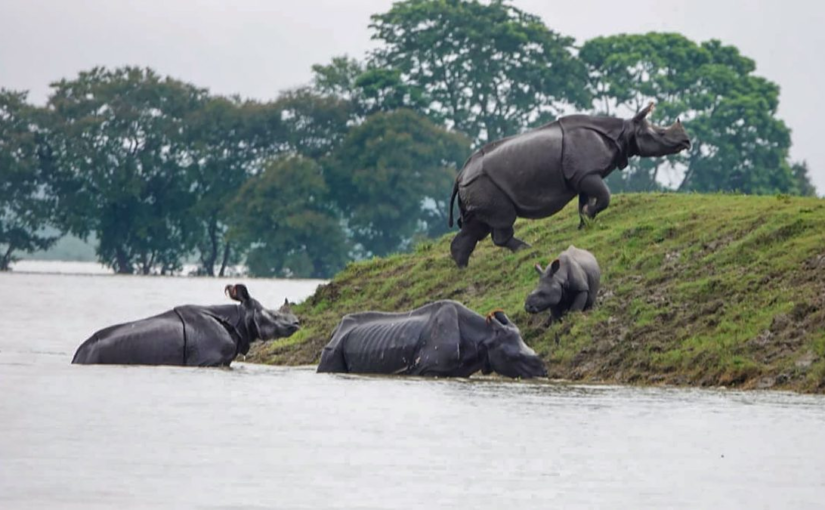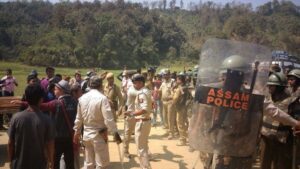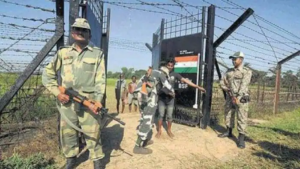While the floods have replenished the natural ecosystem of the wildlife sanctuary, high flood levels have been a matter of concern.

Floods in Kaziranga National Park
The Kaziranga national park, which is located between Karbi Anglong Hills and Bramhaputra river has been vulnerable to floods every year. ‘It is a marshy ecosystem and not a dryland ecosystem’ opines P Sivakumar Director, Kaziranga National Park, speaking to the Indian Express. The entire region of Kaziranga is naturally set up from the Alluvial soil deposited by the Bramhaputra and its tributaries.
Uttam Saikia, Honorary Wildlife Warden of Kaziranga, speaking to the Indian express told, ‘The alluvial plains ecosystem not only was formed by floods but the system replenishes itself. Adding further, he said ‘The ecosystem formed by wetlands, grasslands and semi-deciduous forests holds the regenerative floods which help in the breeding of fish and when the water recedes, they carry the fish into the river which in turn helps nurture the stock of fish in the Bramhaputra river’.
The floodwaters also help the forest to do away with unfavourable plants like water hyacinth which grows in large numbers in the area. For a naturally herbivorous dominant environment, like the Kaziranga, if the annual floods didn’t occur, the area would have become a woodland’ said Sivakumar speaking to the Indian Express.
Read More: Mizoram Governor felicitates daily wager’s daughter who secured 8th rank in class 12 exams
Rabindra Sarma, Research Wildlife officer since 1998 told the Indian Express that the floods have paved way for natural selection making the mighty animals which could survive the floods and not the weak ones.
Ratin Barman, who heads the Centre for Wildlife Rehabilitation and Conservation (CWRC, told the Indian Express that the wildlife sanctuary witnessed mammoth floods once in ten years. However, due to deforestation in the watershed areas and release of water from dams might be a contributing factor. The CWRC manages the welfare injured animals of the wildlife sanctuary.
The climate change has been a contributory factor for the massive floods each year of late. Similar floods have ravaged the UNESCO heritage park almost every year since 2016 with 60% of the area flooded each year resulting in many deaths of the animals.
While the animals used to adapt to the normal annual floods, of late, with the massive floods breaking the threshold level in the wildlife park forces them to move onto safer areas in Karbi Anglong hills
Earlier, there weren’t any barriers between the hills and the wildlife park. However, with the national highway that passes through the area has made it tough for the animals as most of the wildlife corridors witness huge traffic
Read More: Sikkim all set to start homeschooling for elementary education
Dr Naveen Pandey, Deputy Director and Veterinary Advisor told the Indian Express that ‘the recent boom of hotels, shops and the sprouting of tea industry has added to the challenges for the access to the natural habitat for the animals’. Subsequently, the animals are either prone to accidents with speeding vehicles that ply by or have been vulnerable to poachers who exploit the easy access to their advantage through the number of casualties has dwindled recently with strict patrolling in place. The rest of the animals, mostly old and young end up drowning in the gushing waters trying to swim across the overflowing rubbles and the water
Dr Varun Goswami, the Senior Scientist at Conservation Initiatives, an Assam-based organization that works in the Kaziranga landscape, told the Indian Express that traditionally the wildlife has adapted to the routine floods by moving to the highlands and if their secured habitat is not conserved, this accounts to more losses’
This year, a number of Rhinos, boar and deer have drowned 14 deers succumbed under the speeding wheels on the highway. The authorities, however, are yet to reveal the actual fatalities only when the floodwater subsides.
How this affects the bordering villages
The increased floodwaters force the animals to move to safer lands affecting the bordering villages. Nearly 25 out of 75 villages have been vulnerable to the human-animal conflict. Speaking to the Indian Express Mr Sarma, told ‘The wildlife authorities along with the villagers and the conservation organizations like the CWRC have been actively involved in the rescue of the animals and to help them to move to safer habitats.
Measures taken for the preparedness of the flood
The authorities begin to monitor the water level of the Bramhaputra and its tributaries a month earlier to the flood season. Mr Pandey told the Indian Express that ‘A joint venture of local authorities and civilians along with NGOs for wildlife conservation, work hand in hand to tackle the floods. To halt the outbreak of any disease, vaccination is provided to every household in the locality before every flood season. Awareness camps are held every year to educate the locals about poaching which has resulted in less number of cases. Apart from this, section 144 is levied every flood season with speed limits on the national highway is monitored and barricades placed around Karbi Anglong area for the vehicles to ‘slow down’ for the animals to get past the highway safely.




















For example, Haworthia retusa (star cactus) and Haworthia truncata.
Also visit my webpage: Shasta
A quick look into the basics of tips on how to look after a canine.
my site :: Brayden
The fats leaves can be in brown, gray, cream or green colours and have a bumpy texture.
Feel free to surf to my web page … Clarissa
A great example of photoshopping is the well-named Bunny Ear succulent (Monilaria moniliformisorMonilaria obconica).
Here is my website: Bart
The fat leaves may be in brown, grey, cream or inexperienced colours and have a bumpy texture.
my web site … Thao
They’re a number of the easiest succulents to care for as well
– you’ll know when to water whenever you see the leaves start to wrinkle.
My webpage :: Micki
Even if they’re open, it’s not suggested to go to one during
this time.
Feel free to visit my site: Will